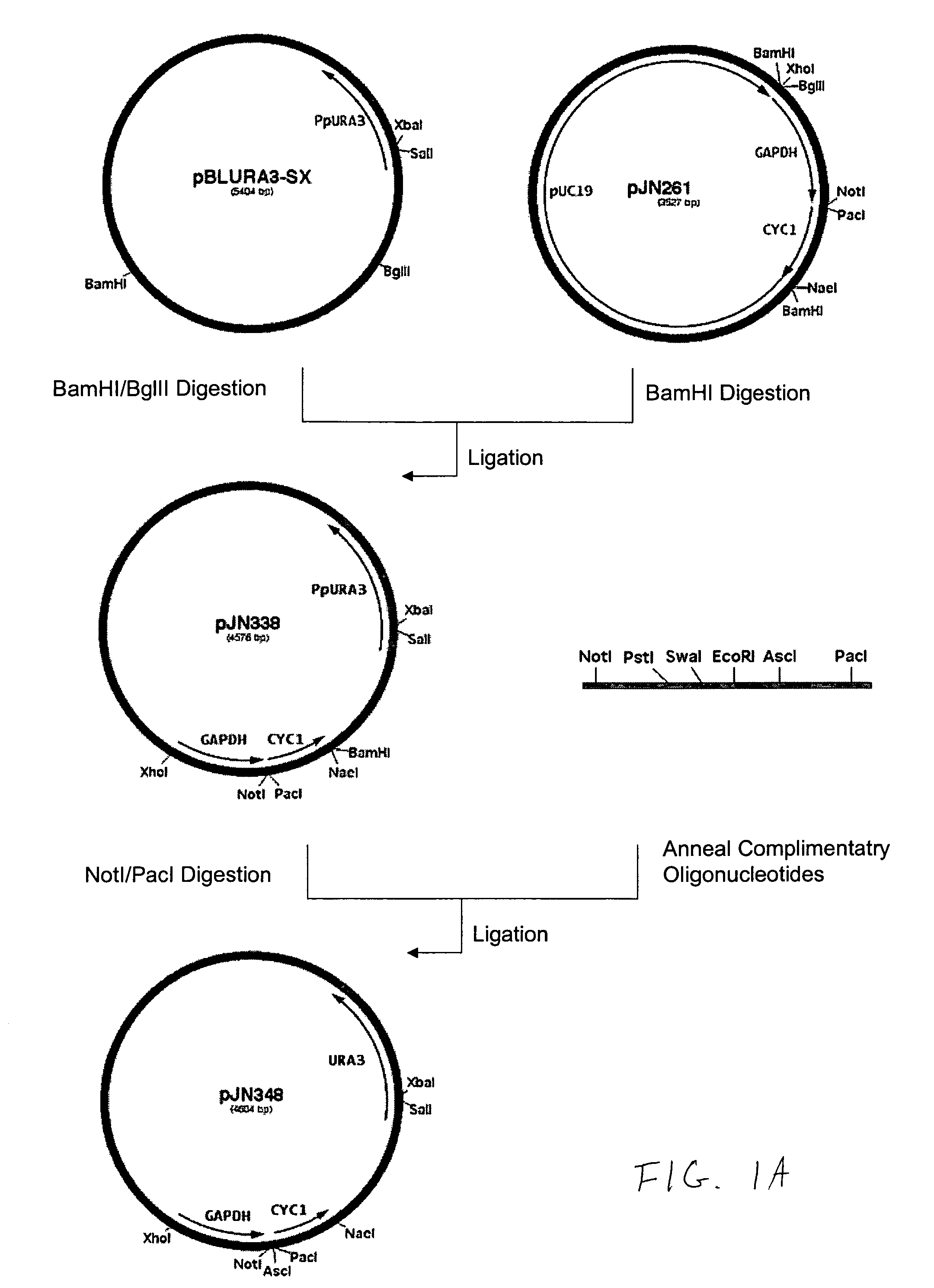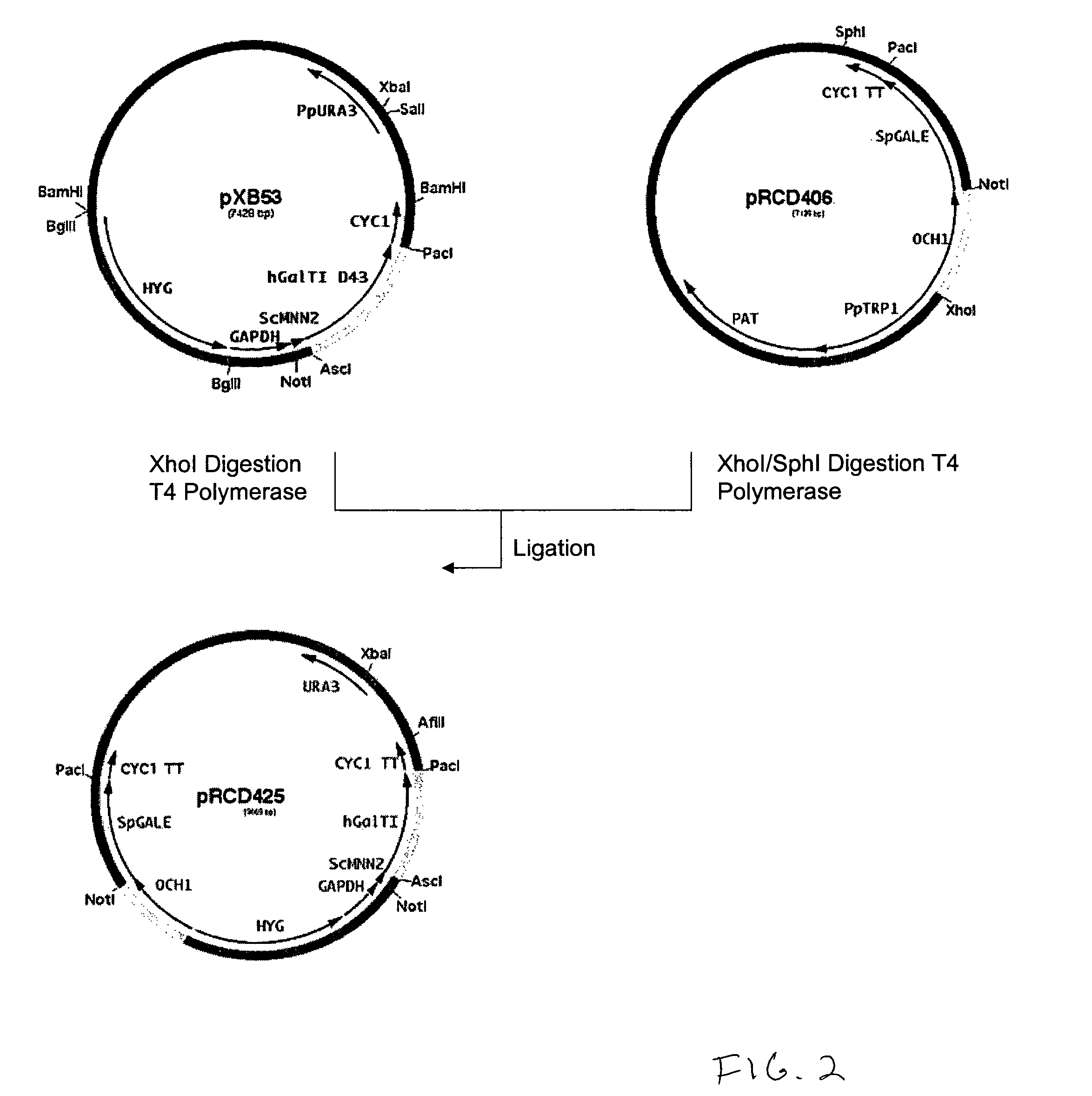Production of galactosylated glycoproteins in lower eukaryotes
a technology of galactosylated glycoproteins and eukaryotes, which is applied in the direction of enzymology, peptide/protein ingredients, transferases, etc., can solve the problem of low conversion efficiency
- Summary
- Abstract
- Description
- Claims
- Application Information
AI Technical Summary
Benefits of technology
Problems solved by technology
Method used
Image
Examples
example 1
Construction of Promoter Cassettes and Expression Vectors
[0194]The 800 bp promoter for the PpOCH1 gene was amplified using primers RCD48 (SEQ ID NO:15) (5′-TATGCGGCCGCGGCTGATGATATTTGCTACGA-3′) and RCD134 (SEQ ID NO:16) (5′-CCTCTCGAGTGGACACAGGAGACTCAGAAACAG-3′) and the 400 bp promoter for the PpSEC4 gene was amplified using primers RCD156 (SEQ ID NO:17) (5′-CTTCTCGAGGAAGTAAAGTTGGCGAAACTT-3′) and RCD157 (SEQ ID NO:18) (5′-CTTAGCGGCCGCGATTGTTCGTTTGAGTAGTTT-3′). The PCR products were cloned into the pCR2.1 cloning vector (Invitrogen) and sequenced. The OCH1 and SEC4 promoters were then subcloned into the vector pJN261 (Nett et al., Yeast. 2003 November; 20(15):1279-90) in place of the GAPDH promoter using the introduced XhoI / NotI restriction sites to create plasmids pRCD360 and pRCD362, respectively.
[0195]The PpHIS3 promoter was PCR amplified using primers RCD152 (SEQ ID NO:19) (5′-CTTCTCGAGGGCATTCAAAGAAGCCTTGGG-3′) and RCD 153 (SEQ ID NO:20) (5′-CTTAGCGGCCGCTGAGTGGTCATGTGGGAACTT-3′), c...
example 2
Cloning of Galactose Transporters
Schizosaccharomyces pombe UDP Galactose Transporter
[0198]The S. pombe gene encoding the UDP Galactose Transporter (SpGMS1+, Genbank AL022598) referred to as SpUGT was PCR amplified from S. pombe genomic DNA (ATCC24843) in two pieces to eliminate a single intron. Primers RCD164 (SEQ ID NO:7) (5′-CCTTGCGGCCGCATGGCTGTCAAGGGCGACGATGTCAAA-3′) and RCD177 (SEQ ID NO:8) (5′-ATTCGAGAATAGTTAAGTGTCAAAATCAATGCACTATTTT-3′) were used to amplify the 5′ 96 bp of the gene and primers RCD176 (SEQ ID NO:9) (5′-AAAATAGTGCATTGATTTTGACACTTAACTATTCTCGAAT-3′) and RCD 165 (SEQ ID NO:10) (5′-CCTTTTAATTAATTAATGCTTATGATCAACGTCCTTAGC-3′) to amplify the 3′ 966 bp. Subsequently, primers RCD164 (SEQ ID NO:7) and RCD165 (SEQ ID NO:10) were used to overlap the two amplified products into a single PCR fragment comprising one contiguous open reading frame with NotI and PacI sites introduced at the ends. This PCR product was cloned into the pCR2.1 vector (Invitrogen) and sequenced. The ...
example 3
Cloning UDP-Galactose-4-Epimerase Genes
S. cerevisiae UDP-Galactose 4-Epimerase
[0202]The S. cerevisiae gene encoding UDP-galactose 4-epimerase (ScGAL10) was PCR amplified from S. cerevisiae genomic DNA using primers RCD270 (SEQ ID NO:31) (5′-TAGCGGCCGCATGACAGCTCAGTTACAAAGTGAAAG-3′) and RCD271 (SEQ ID NO:32) (5′-CGTTAATTAATCAGGAAAATCTGTAGACAATCTTGG-3′). The resulting PCR product was cloned into pCR2.1 and sequenced.
[0203]The ScGAL10 gene was then subcloned using the NotI / PacI sites into plasmids pRCD393 and pRCD394 to create plasmids pRCD395 and pRCD396, respectively and also into plasmids pRCD402 and pRCD403 to create plasmids pRCD404 and pRCD405, respectively. Plasmids pRCD402 and pRCD403 are expression vectors containing the P. pastoris OCH1 and SEC4 promoters, respectively, and the PpCYC1 terminator and convenient restriction sites that were used to fuse the epimerases with these promoters and create a cassette that could be collectively moved into another plasmid.
Homo sapiens UDP...
PUM
| Property | Measurement | Unit |
|---|---|---|
| Tm | aaaaa | aaaaa |
| temperatures | aaaaa | aaaaa |
| temperature | aaaaa | aaaaa |
Abstract
Description
Claims
Application Information
 Login to View More
Login to View More - R&D
- Intellectual Property
- Life Sciences
- Materials
- Tech Scout
- Unparalleled Data Quality
- Higher Quality Content
- 60% Fewer Hallucinations
Browse by: Latest US Patents, China's latest patents, Technical Efficacy Thesaurus, Application Domain, Technology Topic, Popular Technical Reports.
© 2025 PatSnap. All rights reserved.Legal|Privacy policy|Modern Slavery Act Transparency Statement|Sitemap|About US| Contact US: help@patsnap.com



